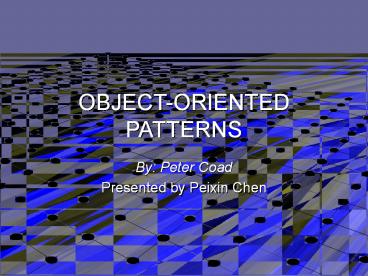OBJECT-ORIENTED PATTERNS - PowerPoint PPT Presentation
Title:
OBJECT-ORIENTED PATTERNS
Description:
OBJECT-ORIENTED PATTERNS By: Peter Coad Presented by Peixin Chen What is pattern? Pattern A fully realized form, original, or model accepted or proposed for imitation ... – PowerPoint PPT presentation
Number of Views:188
Avg rating:3.0/5.0
Title: OBJECT-ORIENTED PATTERNS
1
OBJECT-ORIENTED PATTERNS
- By Peter Coad
- Presented by Peixin Chen
2
What is pattern?
- Pattern
- A fully realized form, original, or model
accepted or proposed for imitation something
regarded as a normative example to be copied
archetype exemplar. - Patterns apply to many disciplines.
3
How to discover patterns?
- Look more carefully to find out what it really
is that is repeating there - Each building or town is defined by certain
patterns of relationships among the elements - These relationships are not extra, but necessary
to the elements
4
Patterns in OOA/OOD
- Class and its object are the elements in
low-level building block, and they are the
constantly repeating lowest-level elements. - Patterns of lowest-level elements and
relationships between them form a building block
for more effective OOA and OOD. - Existing patterns generalization-specification,
whole-part, association, and messaging.
5
Object-oriented patterns
- An object-oriented pattern is an abstraction of a
double, triplet, or other small grouping of
classes that is likely to be helpful again and
again in object-oriented development. - Patterns are found by trial-and-error and by
observation.
6
Severn Patterns -- Notation
Attributes are listed in the center section. They
depict what an object knows
Services are listed in the lower section. They
define what an object does
ClassName
Attribut1 Attribute2
Service 1 Service 2
This is a class symbol. It has no directly
corresponding objects
This is a class--object symbol. The lighter
border represents an object in that class.
7
Notation (2)
GeneralizationClass
Whole
SpecializaitonClass
Part
Gen-spec structure
Whole-part structure
8
Notation (3)
Receiver
Sender
The solid line is an association connection,
indicating that one object needs to know about
another object. The arrow is a message
connection .
9
Item description pattern
Item description
Item
Guideline when some attribute values may apply
to more than one object in a class.
aircraftDescription Model manufacture
Aircraft tailnum
Aircraft tailnum
10
Time Association Pattern
Guideline whenever the system is responsible to
know an association between two or more objects
and to know or do something about that association
If participant1 and participant2 is in one
association, and one needs to express attributes
or services regarding that association, then an
object from time association is needed
11
Event Logging Pattern
EventRemembered
Device
Guideline whenever an event is detected, and you
need to log its occurrence to support
after-the-fact analysis or to meet legal
requirements.
12
Role Played Pattern
Player
Guideline whenever you have a player object
which remains the same old player object, but has
different attributes and services.
PlayerRole
More concise and flexible than attempting to use
multiple inheritance to model a large numbers of
roles.
PlayerRole1
PlayerRole2
13
State Across a Collection
Collection
Member
Guideline whenever there is a whole-part
relationship, and one or more attributes apply to
the whole.
14
Behavior Across a Collection Pattern
Collection
Guideline whenever there is a whole-part
relationship and a behavior applies across the
whole collection. A collection object has a
behavior that applies across an entire collection
of its member objects.
Member
Caution only put behavior that really applies
across the collection up into collection object.
15
Broadcast Pattern
BroadcastingItem
ReceivingItem
This pattern is used to communicate complex
changes between one major section of an OOA/OOD
model with another major section. In ParcPlace
Systems ObjectWorks, this application of a
broadcast pattern is called model-view-controller
(MVC). Guideline Use this pattern to establish
interactions between major OOA/OOD parts in a way
that two sections stay cleanly separated.
16
MVC
- In the MVC paradigm the user input, the modeling
of the external world, and the visual feedback to
the user are explicitly separated and handled by
three types of object, each specialized for its
task. - The view manages the graphical and/or textual
output to the portion of the bitmapped display
that is allocated to its application. - The controller interprets the mouse and keyboard
inputs from the user, commanding the model and/or
the view to change as appropriate. - Finally, the model manages the behavior and data
of the application domain, responds to requests
for information about its state (usually from the
view), and responds to instructions to change
state (usually from the controller). - The MVC behavior is then inherited, added to, and
modified as necessary to provide a flexible and
powerful system.
17
Summary
- A pattern is a fully realized form, original, or
model accepted or proposed for imitation. - With patterns, small piecework is standardized
into a larger chunk or unit. - Patterns become the building blocks for design
and construction. - Finding and applying patterns indicates progress
in a field of human endeavor.
The End































